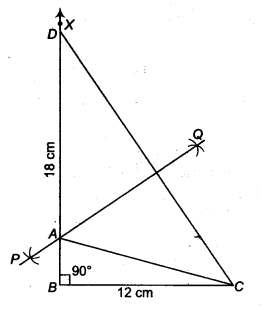Question 1.
Construct an angle of 90° at the initial point of a given ray and justify the construction.
Solution:
Steps of construction
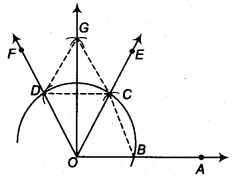
- Taking O as centre and some radius, draw an arc of a circle which intersects OA say at a point B.
- Taking B as centre and with the same radius as before, draw an arc intersecting the previously drawn arc, say at a point C.
- Taking C as centre and with the same radius as before, draw an arc intersecting the arc drawn in step 1, say at D.
- Draw the ray OE passing through C.
Then, ∠EOA = 60°
- Draw the ray of passing through D. Then, ∠FOE = 60°.
- Next, taking Cand Das centres and with the radius more than 1/2 CD, draw arcs to intersect each other, say at G.
- Draw the ray OG. This ray OG is the bisector of the ∠FOE i.e.,
∠FOG = ∠EOG =1/2 ∠FOE =1/2 (60°) = 30°
Thus, ∠GOA = ∠GOE + ∠EOA
= 30° + 60° = 90°
Justification
(i) Join BC.
Then, OC=OB = BC (By construction)
∴ ∆COB is an equilateral triangle.
∴ ∠COB = 60°
∴ ∠EOA = 60°
(ii) Join CD.
Then, OD=OC=CD (By construction)
∴ ∆DOC is an equilateral triangle.
∴ ∠DOC = 60°
∴ ∠FOE = 60°
(iii) Join CG and DG.
In ∆ODG and ∆OCG,
OD = OC (Radii of the same arc)
DG = CG (Arcs of equal radii)
OG = OG (Common)
∴ ∆ ODG ≅ ∆OCG (SSS rule)
∴ ∠DOG = ∠COG (CPCT)
∴ ∠FOG = ∠EOG = 12 ∠FOE
= 12 (60°) = 30°
Thus, ∠GOA = ∠GOE + ∠EOA = 30° + 60° = 90°
Question 2.
Construct an angle of 45° at the initial point of a given ray and justify the construction.
Solution:
Steps of construction
- Taking O as centre and some radius, draw an arc of a circle which intersects OA, say at a point B.
- Taking B as centre and with the same radius as before, draw an arc intersecting the previously drawn arc, say at a point C.
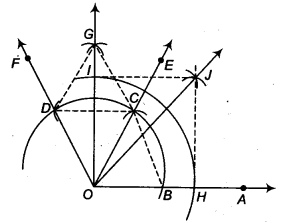
- Taking C as centre and with the same radius as before, draw an arc intersecting the arc drawn in step 1, say at D.
- Draw the ray OE passing through C. Then, ∠EOA = 60°.
- Draw the ray OF passing through D. Then, ∠FOE = 60°.
- Next, taking C and D as centres and with radius more than 1/2 CD, draw arcs to intersect each other, say at G.
- Draw the ray OG. This ray OG is the bisector of the ∠FOE,
i.e., ∠FOG = ∠EOG =1/2 ∠FOE =1/2 (60°) = 30°.
thus , ∠GOA = ∠GOE + ∠EOA
= 30° + 60° = 90°
- Now taking O as centre and any radius, draw an arc to intersect the rays OA and OG, say at Hand /, respectively.
- Next, taking H and las centres and with the radius more than 1/2 Hl, draw
arcs to intersect each other, say at J.
- Draw the ray OJ. This ray OJ is the required bisector of the ∠GOA.
∠GOJ = ∠AOJ =1/2 ∠GOA
=1/2 (90°) = 45°
Justification
(i) Join BC. (By construction)
Then, OC = OB = BC
∴ ∆COB is an equilateral triangle.
∴ ∠COB = 60°
∴ ∠EOA = 60°
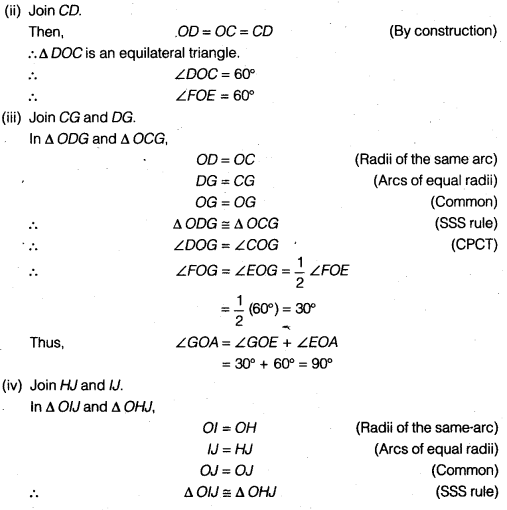

Question 3.
Construct the angles of the following measurements
- (i) 30°
- (ii) 22 12
- (iii) 15°
Solution:
(i) Steps of construction
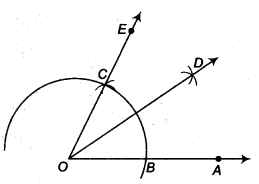
- Taking O as centre and some radius, draw an arc of a circle which intersects OA, say at a point B.
- Taking B as centre and with the same radius as before, draw an arc intersecting the previously drawn arc, say at a point C.
- Draw the ray OE passing through C. Then, ∠EOA = 60°.
- Taking B and C as centres and with the radius more than 1/2 BC, draw arcs to intersect each other, say at D.
- Draw the ray OD, this ray OD is the bisector of the ∠EOA, i.e.,
∠EOD = ∠AOD =1/2 ∠EOA =1/2 (60°) = 30°
(ii) Steps of construction
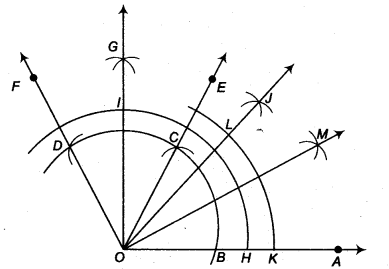
- aking O as centre and some radius, draw an arc of a circle which, intersects OA, say at a point B.
- Taking B as centre and with the same radius as before, draw an arc intersecting the previously drawn arc, say at a point C.
- Taking C as centre and with the same radius as before, drawn an arc intersecting the arc drawn in step 1, say at D.
- Draw the ray OE passing through C. Then, ∠EOA = 60°.
- Draw the ray OF passing through D. Then, ∠FOE = 60°.
- Next, taking C and D as centres and with radius more than 1/2 CD, draw arcs to intersect each other, say at G.
- Draw the ray OG. This ray OG is the bisector of the ∠FOE,
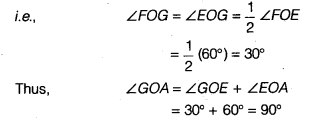
- Now, taking O as centre and any radius, draw an arc to intersect the rays OA and OG, say at H and l, respectively.
- Next, taking H and l as centres and with the radius more than 1/2 Hl, draw arcs to intersect each other, say at J.
- Draw the ray OJ. This ray OJ is the bisector of the ∠GOA
i. e., ∠GOJ = ∠AOJ =1/2 ∠GOA
=1/2 (90°) = 45 °
- Now, taking O as centre and any radius, drawn an arc to intersect the rays OA and OJ, say at K and L, respectively.
- Next, taking K and L as centres and with the radius more than 12KL, draw arcs to intersect each other, say at H.
- Draw the ray OM. This ray OM is the bisector of the ∠AOJ, i.e., ∠JOM = ∠AOM
=1/2 ∠AOJ = 1/2 (45°) = 22 1/2 °
(iii) Steps of construction
- Taking O as centre and some radius, draw an arc of a circle which intersects OA say at a point B.
- Taking B as centre and with the same radius as before, draw an arc intersecting the previously drawn arc, say at a point C..
- Draw the ray OE passing through C. Then, ∠EOA = 60°.
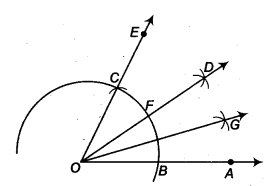
- Now, taking 6 and Cas centres and with the radius more than 1/2 BC, draw arcs to intersect each other, say at D.
- Draw the ray OD intersecting the arc drawn in step 1 at F. This ray OD is the bisector of the ∠EOA, i.e.,
∠EOD = ∠AOD =1/2 ∠EOA =1/2 (60°) = 30°
- Now, taking B and F as centres and with the radius more than 1/2 BF, draw arcs to intersect each other, say at G.
- Draw the ray OG. This ray OG is the bisector of the ∠AOD,
i. e., ∠DOG = ∠AOG =1/2 ∠AOD =1/2 (30°) = 15°
Question 4.
Construct the following angles and verify by measuring them by a protractor
- (i) 75°
- (ii) 105°
- (iii) 135°
Solution:
(i) Steps of construction
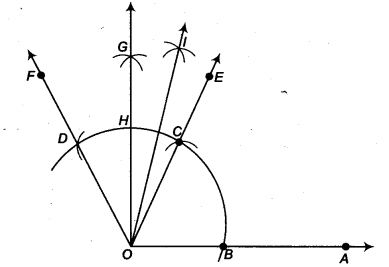
- Taking O as centre and some radius, draw an arc of a circle which intersects OA say at a point B.
- Taking B as centre and with the same radius as before, draw an arc intersecting the previously drawn arc, say at a point C.
- Taking C as centre and with the same radius as before, draw an arc intersecting the arc drawn in step 1, say at D.
- Join the ray OE passing through C. Then, ∠EOA = 60°.
- Draw the ray of passing through D. Then, ∠FOE = 60°.
- Next, taking C and D as centres and with the radius more than 1/2 CD, draw arcs to intersect each other, say at G.
- Draw the ray OG intersecting the arc of step 1 at H. This ray OG is the bisector of the ∠FOE, i.e., ∠FOG =∠EOG
=1/2 ∠FOE = 1/2(60°) = 30°
- Next, taking Cand H as centres and with the radius more than 1/2CH, draw
arcs to intersect each other, say at l.
Draw the ray OI. This ray OI is the bisector of the ∠GOE,
i. e., ∠GOI = ∠EOI =1/2 ∠GOE =1/2 (30°) = 15°
Thus, ∠IOA = ∠IOE + ∠EOA
=15°+ 60° = 75°
On measuring the ∠IOA by protractor, we find that ∠IOA = 15°
Thus, the construction is verified.
(ii) Steps of construction
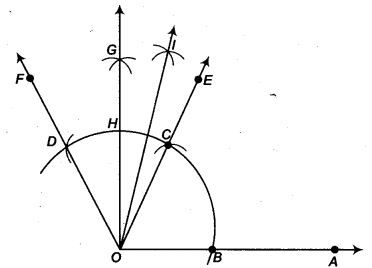
- Taking O as centre and some radius, draw an arc of a circle which intersects OA say at a point B.
- Taking B as centre and with the same radius as before, draw an arc intersecting the previously drawn arc, say at a point C.
- Taking C as centre and with the same radius as before, draw an arc intersecting the arc drawn in step 1, say at a point D.
- Draw the ray Of passing through C. Then, ∠EOA = 60°.
- Draw the ray OF passing through D. Then, ∠FOE = 60°.
- Next, taking Cand Das centres and with the radius more than 1/2 CD, draw arcs to intersect each other, say at G.
- Draw the ray OG intersecting the arc drawn in step 1 at H. This ray OG is the bisector of the ∠FOE, i.e.,
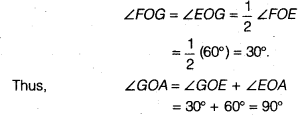
- Next, taking H and D as centres and with the radius more than 1/2 HD, draw arcs to intersect each other, say at l.
- Draw the ray Ol. This ray Ol is the bisector of the ∠FOG, i.e.,

Thus, ∠lOA = ∠IOG + ∠GOA = 15° + 90° = 105°. On measuring the ∠lOA by protractor, we find that ∠FOA = 105°.
Thus, the construction is verified.
(iii) Steps of construction
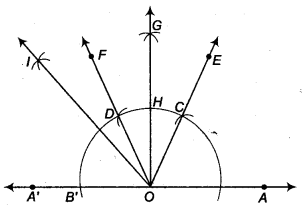
- Produce AO to A’ to form ray OA’.
- Taking O as centre and some radius, draw an arc of a circle which intersects OA at a point B and OA’ at a point B’.
- Taking B as centre and with the same radius as before, draw an arc intersecting the previously drawn arc at a point C.
- Taking C as centre and with the same radius as before, draw an arc intersecting the arc drawn in step 1, say at D.
- Draw the ray OE passing through C, then ∠EOA = 60°.
- Draw the ray OF passing through D, then ∠FOE = 60°.
- Next, taking C and D as centres and with the radius more than1/2 CD, draw arcs to intersect each other, say at G.
- Draw the ray OGintersecting the arc drawn in step 1 at H. This ray OG is the bisector of the ∠FOE i,e.,

- Next, taking B’ and H as centres and with the radius more than1/2 B’H, drawn arcs to intersect each other, say at l.
- Draw the ray Ol. This ray Ol is the bisector of the ∠B’OG i.e.,

On measuring the ∠IOA by protractor, we find that ∠lOA = 135°.
Thus, the construction is verified.
Question 5.
Construct an equilateral triangle, given its side and justify the construction.
Solution:
Steps of construction
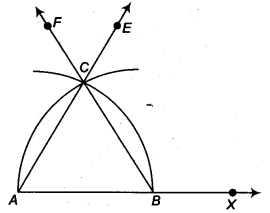
- Take a ray AX with initial point A From AX, cut off AB = 4 cm.
- Taking A as centre and radius (= 4 cm), draw an arc of a circle, which intersects AX, say at a point B.
- Taking B as centre and with the same radius as before, draw an arc intersecting the previously drawn arc, say at a point C.
- Draw the ray AE passing through C.
- Next, taking B as centre and radius (= 4 cm), draw an arc of a circle, which intersects AX, say at a point A
- Taking A as centre and with the same radius as in step 5, draw an arc intersecting the previously drawn arc, say at a point C.
Draw the ray BF passing through C.
Then, ∆ ABC is the required triangle with gives side 4 cm.
Justification
AB = BC (By construction)
AB = AC (By construction)
∴ AB = BC = CA
∴ ∆ ABC is an equilateral triangle.
∴ The construction is justified.
Question 1.
Construct a ∆ ABC in which BC = 7 cm, ∠B = 75° and AB + AC = 13 cm.
Solution:
Given that, in ∆ ABC, BC = 7 cm, ∠B = 75° and AS + AC = 13 cm
Steps of construction
- Draw the base BC = 7 cm
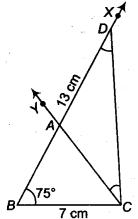
- At the point 6 make an ∠XBC = 75°.
- Cut a line segment BD equal to AB + AC = 13 cm from the ray BX.
- Join DC.
- Make an ∠DCY = ∠BDC.
- Let CY intersect BX at A.
Then, ABC is the required triangle.
Question 2.
Construct a ∆ ABC in which BC = 8 cm,∠B = 45° and AB - AC = 35 cm.
Solution:
Given that, in ∆ ABC,
BC = 8 cm, ∠B = 45°and AB – AC = 3.5 cm
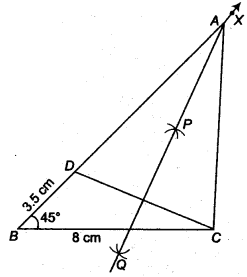
Steps of construction
- Draw the base BC = 8 cm
- At the point B make an ∠XBC = 45°.
- Cut the line segment BD equal to AB - AC = 3.5 cm from the ray BX.
- Join DC.
- Draw the perpendicular bisector, say PQ of DC.
- Let it intersect BX at a point A
- Join AC.
Question 3.
Construct a ∆ ABC in which QR = 6 cm, ∠Q = 60° and PR - PQ = 2 cm.
Solution:
Given that, in ∆ ABC, QR = 6 crn ∠Q = 60° and PR - PQ = 2 cm
Steps of construction
- Draw the base QR = 6 cm
- At the point Q make an ∠XQR = 60°.
- Cut line segment QS = PR- PQ (= 2 cm) from the line QX extended on opposite side of line segment QR.
- Join SR.
- Draw the perpendicular bisector LM of SR.
- Let LM intersect QX at P.
- Join PR.
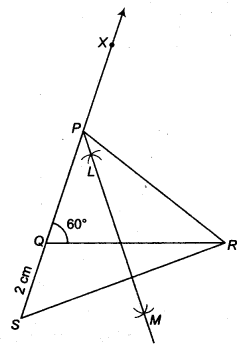
Question 4.
Construct a ∆ XYZ in which ∠Y = 30°, ∠Y = 90° and XY + YZ + ZX = 11 cm.
Solution:
Given that, in ∆XYZ ∠Y = 30°, ∠Z = 90° and XY + YZ + ZX = 11cm
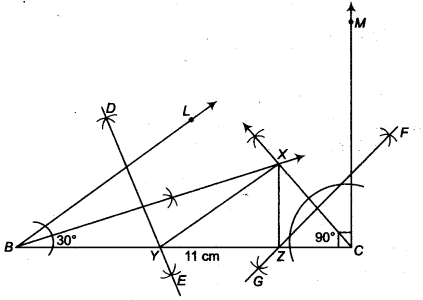
Steps of construction
- Draw a line segment BC = XY + YZ + ZX = 11 cm
- Make ∠LBC = ∠Y = 30° and ∠MCB = ∠Z = 90°.
- Bisect ∠LBC and ∠MCB. Let these bisectors meet at a point X.
- Draw perpendicular bisectors DE of XB and FG of XC.
- Let DE intersect BC at Y and FC intersect BC at Z.
- Join XY and XZ.
Then, XYZ is the required triangle.
Question 5.
Construct a right triangle whose base is 12 cm and sum of its hypotenuse and other side is 18 cm.
Solution:
Given that, in A ABC, base BC = 12 cm, ∠B = 90° and AB + BC= 18 cm.
Steps of construction
- Draw the base BC = 12 cm
- At the point 6, make an ∠XBC = 90°.
- Cut a line segment BD = AB+ AC = 18 cm from the ray BX.
- Join DC.
- Draw the perpendicular bisector PQ of CD to intersect SD at a point A
Join AC.
Then, ABC is the required right triangle.
